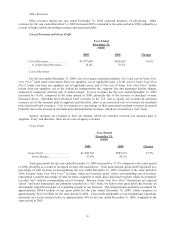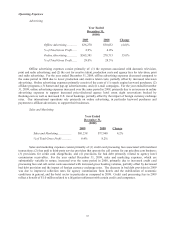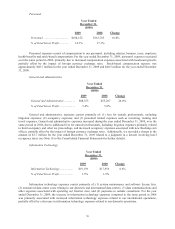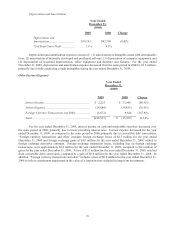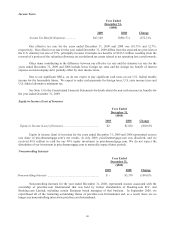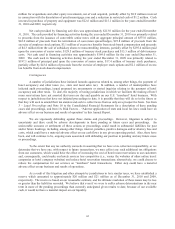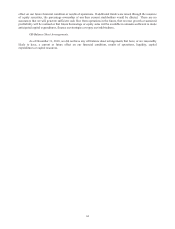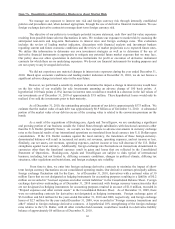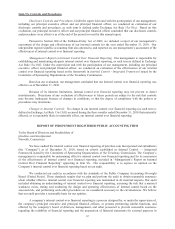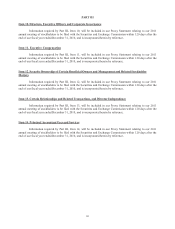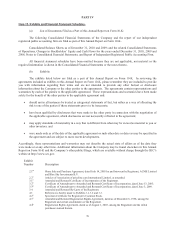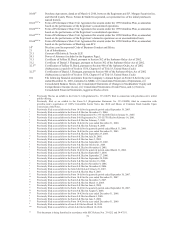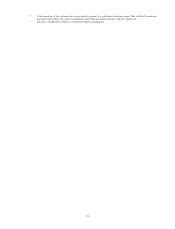Priceline 2010 Annual Report Download - page 139
Download and view the complete annual report
Please find page 139 of the 2010 Priceline annual report below. You can navigate through the pages in the report by either clicking on the pages listed below, or by using the keyword search tool below to find specific information within the annual report.
65
Item 7A. Quantitative and Qualitative Disclosures about Market Risk
We manage our exposure to interest rate risk and foreign currency risk through internally established
policies and procedures and, when deemed appropriate, through the use of derivative financial instruments. We use
foreign exchange derivative contracts to manage short-term foreign currency risk.
The objective of our policies is to mitigate potential income statement, cash flow and fair value exposures
resulting from possible future adverse fluctuations in rates. We evaluate our exposure to market risk by assessing the
anticipated near-term and long-term fluctuations in interest rates and foreign exchange rates. This evaluation
includes the review of leading market indicators, discussions with financial analysts and investment bankers
regarding current and future economic conditions and the review of market projections as to expected future rates.
We utilize this information to determine our own investment strategies as well as to determine if the use of
derivative financial instruments is appropriate to mitigate any potential future market exposure that we may face.
Our policy does not allow speculation in derivative instruments for profit or execution of derivative instrument
contracts for which there are no underlying exposures. We do not use financial instruments for trading purposes and
are not a party to any leveraged derivatives.
We did not experience any material changes in interest rate exposures during the year ended December 31,
2010. Based upon economic conditions and leading market indicators at December 31, 2010, we do not foresee a
significant adverse change in interest rates in the near future.
However, we performed a sensitivity analysis to determine the impact a change in interest rates would have
on the fair value of our available for sale investments assuming an adverse change of 100 basis points. A
hypothetical 100 basis points (1.0%) increase in interest rates would have resulted in a decrease in the fair values of
our investments as of December 31, 2010 of approximately $3.8 million. These hypothetical losses would only be
realized if we sold the investments prior to their maturity.
As of December 31, 2010, the outstanding principal amount of our debt is approximately $575 million. We
estimate that the market value of such debt was approximately $0.9 billion as of December 31, 2010. A substantial
portion of the market value of our debt in excess of the carrying value is related to the conversion premium on the
bonds.
As a result of the acquisitions of Booking.com, Agoda and TravelJigsaw, we are conducting a significant
and growing portion of our business outside the United States through subsidiaries with functional currencies other
than the U.S. Dollar (primarily Euros). As a result, we face exposure to adverse movements in currency exchange
rates as the financial results of our international operations are translated from local currency into U.S. Dollars upon
consolidation. If the U.S. Dollar weakens against the local currency, the translation of these foreign-currency-
denominated balances will result in increased net assets, net revenues, operating expenses, and net income or loss.
Similarly, our net assets, net revenues, operating expenses, and net income or loss will decrease if the U.S. Dollar
strengthens against local currency. Additionally, foreign exchange rate fluctuations on transactions denominated in
currencies other than the functional currency result in gains and losses that are reflected in the Consolidated
Statement of Operations. Booking.com, Agoda and TravelJigsaw are subject to risks typical of international
business, including, but not limited to, differing economic conditions, changes in political climate, differing tax
structures, other regulations and restrictions, and foreign exchange rate volatility.
From time to time, we enter into foreign exchange derivative contracts to minimize the impact of short-
term foreign currency fluctuations on our consolidated operating results. Our derivative contracts principally address
foreign exchange fluctuation risk for the Euro. As of December 31, 2010, derivatives with a notional value of 30
million Euros that are not designated as hedging instruments for accounting purposes resulting in a liability of $0.2
million are recorded in “Accrued expenses and other current liabilities” in the Consolidated Balance Sheet. Foreign
exchange derivatives outstanding as of December 31, 2010 associated with foreign currency transaction risks that
are not designated as hedging instruments for accounting purposes resulted in an asset of $1.0 million, recorded in
“Prepaid expenses and other current assets” in the Consolidated Balance Sheet. As of December 31, 2009, there
were no outstanding contracts for derivatives not designated as hedging instruments. Foreign exchange gains of
$3.0 million and $4.0 million for the years ended December 31, 2010 and 2008, respectively, and foreign exchange
losses of $2.7 million for the year ended December 31, 2009, were recorded in “Foreign currency transactions and
other” related to foreign exchange derivative contracts. A hypothetical 10% strengthening of the foreign exchange
rates relative to the U.S. Dollar, with all other variables held constant, would have resulted in a derivative liability
balance of approximately $6 million as of December 31, 2010.



